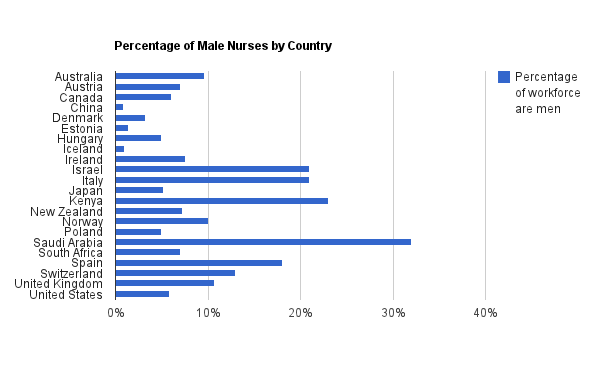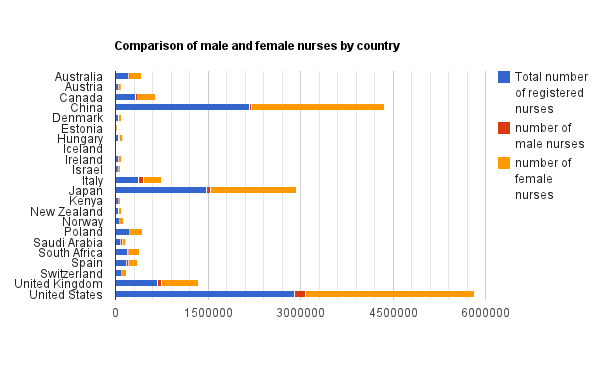Male Nurses Worldwide
International Nurses Day is celebrated all over the world on 12th May, on the anniversary of Florence Nightingale’s birth. Every year the International Council of Nurses commemorates the day by distributing an International Nursing Day kit. The kit includes educational materials about a particular theme – this year it is Closing The Gap: From Evidence to Action and aims to raise awareness of inequalities and to find ways to change practices for the better.
With International Nurses Day approaching I thought I would look at the numbers of male nurses around the world and see how they compared.
As you can see, the numbers of male nurses the world over is low, but there are certain trends. In the UK, men make up 10.6% of the nursing workforce, see our previous post ‘The Rise of The Male Midwife’, and that percentage is rising and has been for the last twenty years. But how does this compare to the rest of the world? In general, European countries all seem to be around the 5-10% mark with a few exceptions. In Iceland, men make up a meagre 1% of nurses. Whereas in Italy, it rises to 21% – one of the highest. In 2007 the Italian Government secured 60,000 jobs for male nurses to combat a nursing shortage, which would account for the rise.
China’s male nurses make up just 1%
China is facing difficulty in hiring male nurses and out of China’s 2.18 million registered nurses only 21,000 are men, that equates to less than 1% of the workforce. A recent article for China Daily online by Zheng Xin shares the frustrations of one man who recognises the need for more male nurses. The article makes a strong cause for why there is a need for male nurses and says misconceptions and negative stereotypes depicting male nurses as effeminate put a lot of men off nursing. Men are just as qualified and capable of nursing as women but the article gives reasons that may encourage more men to take up the profession. It says men are able to assist in moving paralysed patients and they play a vital role in natural disaters such as earthquakes especially when rescuing victims. However in China, money is an issue. The basic wage for a nurse in around 1,500 yuan (£147) and is another reason why men are not attracted to the job. Zhao Yue, director of the School of Nursing of the Tianjin Medical University said, “Nothing will change, until the public changes its attitudes and nurses’ pay is raised”.
Striking Saudi results
What is striking from the data is the high number of male nurses in Saudi Arabia. At 32% it is far higher than elsewhere in the world. There is even a surpless of male nursing graduates, with thousands of graduates on waiting lists for nursing jobs. And yet there is a shortage of female nurses. The disproportionately high numbers of male nurses can be attributed to the social conditions in the Kingdom. Women are limited in the jobs they can do, they do not have equal status as men in many things such as employment and they are banned from driving. Segregation in daily life and the workplace would make difficult to work in a hospital. In Saudi Arabia there is a big shortage of nurses in general and attempts to bring in highly qualified nurses from abroad proves difficult because of low wages. The article from ‘Arab News’ says many nurses from the Philipenes find work in Saudi.
Although nursing figures in India were not available, an article by The World Health Organisation called “Wanted: 2.4 million nurses, and that’s just in India”, it addresses the issue of a worldwide shortage of nurses. It also uncovers some interesting facts. Nursing In India is considered a respectable profession by most sections of Indian society and the acceptability of male nurses has increased over the years. Male nurses are preferred in some of the tribal areas, as they are difficult to access. Some states have taken initiatives to promote male nurses for example, Maharashtra State has reserved 20% of places in its nursing colleges for male students.
Better wages
Currently, in India there is a nursing strike over better wages. Nurses used to form an unorganised group but have formed a new union over the last few months. An average annual salary is 9,000 Rupees (£104) and the nurses are demanding an 80% increase to 15,000 Rupees (£174).
If you want to read more about male nurses in India, this article from the Navhind Times, “When Brothers become Sisters” highlights why a lot of men are going abroad to work and many are training as male nannies.
Thai Police double as midwives!
In areas of the world where traffic congestion is at its most intense the traffic police are trained in midwifery in order to deliver the many babies that are born in traffic jams. It may seem strange at first but is actually a sensible idea. Thai Police in the capital Bangkok, have a few days of medical training each month to learn how to deliver babies. One officer has delivered a huge 81 babies in ten years.
The general trend all over the world is that men in nursing, while still low, is becoming increasingly more poplar. Different societal norms and cultures will always dictate gender gaps but a shortage of nurses worldwide combined with men willing to break down stereotypes can only be a good thing for the profession.
The Data
Data was collated from various Health Workforce reports and Nursing Councils. Due to the inconsistencies in the year of publication for different countries, the data is measured within a general time period from 2005-2010. Although the data is the most recent available, we must allow for some of it to be slightly out of date. This shouldn’t detract from the findings as the data clearly shows that there is a greater percentage of female nurses than male worldwide. From reading reports, articles and accounts, we can understand that the number of men in nursing is generally rising.
Sources
Health Work Force in India
Kenya’s Health Workforce Kenya’s Health Workforce Training Capacity: A Situation Analysis, 2010
Japanese figures from the Japanese Nursing Association
United Kingdom NMC Statistical Analysis of the Register
European data from Workgroup of European Nurse Researchers (WENR) Country Reports 2005-2010
South African data
By Helen Regan. Photo with thanks to Sahaja Meditation


This is a really interesting article and an eye opener into the different attitudes of people towards male nurses around the world. I did not realise the difference in numbers between Saudi Arabia and China. What’s also interesting is that around the world male nurses have different roles such as rescueing people from earthquakes: an interesting fact that I had never thought of before. And you make the point about the low wages in nursing; as men in a lot of cultures are the main workers a nurses wage would not be enough to support the family. Very interesting article!